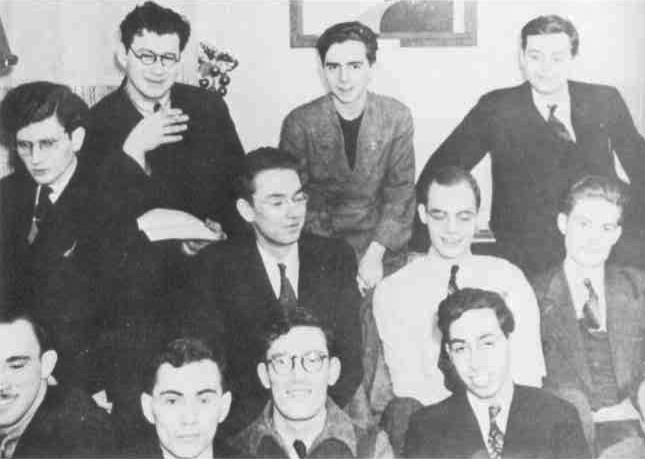I walked out of the house this morning and into the delicious crispness of the first day of fall (ignore what the calendar says; I say it’s summer when I want iced coffee and fall when I want my coffee hot — and I wanted my coffee hot this morning). Fall is books season! And, for a science fiction fan, how better to kick off books season than to dive into decades of fun hoo-hah over SF movements and literary manifestos?
I love to classify things. It’s fun! One of my earliest pleasures was to pour through tomes on dinosaurs and separate out the carnivores from the herbivores, the sauropods from the theropods, etc. Some of the biggest attractants for me to books on naval history and naval architecture were the fine distinctions between protected cruisers, belted cruisers, scout cruisers, armored cruisers, light cruisers, heavy cruisers, and battlecruisers (not to mention submarine cruisers and dynamite cruisers, those endearing oddities).
Lots of SF fans share my mania for classification and taxonomy. And since most professional SF writers have gotten their starts as fans (at least since the days of the Futurians), science fiction has been a fertile playground for those practitioners and armchair theorists who wished to divide between this and that (and oftentimes between us and them, which is when things get really juicy). Sometimes, science fiction movements have been primarily attempts by publishers to goose the market by publicizing “the new hot thing.” But far more often, movements and manifestos have erupted from the passions of fans and writers themselves, flourished or fizzled in the hothouse world of magazine letter columns, fanzines, prozines, scholarly journals, blogs, and convention discussion panels, then mellowed later into tasty subjects for historians and obsessives of the field.
The first genuine movement to have arisen from science fiction (or from science fiction fandom, to be more exact) was that of the Futurians. Much of what we think of as modern science fiction would either not exist or would be radically different had it not been for literary lives of the young men and women who numbered themselves among the Futurians’ ranks in the late 1930s and early 1940s, including Frederik Pohl, Judith Merril, Cyril Kornbluth, James Blish, and Isaac Asimov. For a bit of entertaining deep background on the roots of SF fandom, check out this excerpt (entries beginning with the letter F) from the Fancyclopedia; make special note of articles on Numerical Fandoms, Feuds, and the Futurians. Here’s an article on Fred Pohl’s involvement with the Futurians, and the man himself has written a great deal on those fabulous days of yesteryear, both in his memoir The Way the Future Was and his highly entertaining blog, The Way the Future Blogs (both highly recommended!). Andrew Milner and Robert Savage wrote about the Futurians as the vanguard of utopianism in 1930s SF, and Paul Malmont has blogged movingly on the Futurians and the joys of being involved in the wars and controversies of fandom. Bruce Sterling, lead theorist and popularizer of a more recent movement in science fiction, has claimed the Futurians as direct ancestors of the cyberpunks and lists the infamous 1939 raid by the Secret Service of a communal apartment occupied by the Futurians as part of his Chronology of the Hacker Crackdown.
One of the Futurians, Judith Merril, played a key role in the next major movement to arise from science fiction, the New Wave of the 1960s, a literary and cultural reaction against the vision of science fiction embodied by Astounding/Analog editor John W. Campbell (whose influence on the field was so monumental, he might be considered a one-man movement all on his lonesome). Other leading figures of the New Wave included Michael Moorcock, editor of the key and highly influential British magazine New Worlds; J. G. Ballard, author of classic explorations of “inner space” The Drowned World, The Drought, The Crystal World, and The Atrocity Exhibition; and Harlan Ellison, outspoken editor of landmark anthologies Dangerous Visions and Again, Dangerous Visions. Plenty of polemics and manifestos were published by the movement’s supporters (and detractors); unfortunately, since these were written in the pre-Internet age, much of this material must be hunted down in analog form (here is a helpful bibliography of key documents from the period, including essays by Judith Merril and Harlan Ellison, as well as a listing of essential works of fiction from the period). Here’s a recap of a recent reunion of a number of New Wave luminaries, a July, 2011 event at the British Library featuring Brian Aldiss, John Clute, Michael Moorcock, and Norman Spinrad.
Following all the tumult promulgated by the rolling in (and receding) of the New Wave, science fiction entered a backwards-looking phase in the latter half of the 1970s, dominated by the triumph of Star Wars (an homage to the Edmund Hamilton and Leigh Brackett space operas of the 1930s) and, on the publishing side, by Betty Ballantine’s decision to commission big, fat fantasy novels written in the Tolkien tradition. However, the conservative reaction did not reign unopposed for long. A fresh movement, representing a whole new attitude, outlook, and aesthetic sensibility, burst on the scene in 1984 with the publication of William Gibson’s Neuromancer. Two years later, the young cyberpunk movement found its chief polemicist in Bruce Sterling, who threw down a gauntlet to the rest of the SF field in his Introduction to the cyberpunk anthology Mirrorshades. Here Bruce Sterling looks back at cyberpunk in the Nineties.
Cyberpunk had a good run, but even it eventually came to taste somewhat stale. By 2002, Norman Spinrad was kvetching in the pages of Asimov’s Science Fiction about a lack of recent, exciting movements in science fiction. Lawrence Person had written some notes toward a post-cyberpunk manifesto back in 1999, but not too many appeared ready to jump on that bandwagon. However, Norman need not have been so concerned. The decade of the 2000s would be replete with SF movements, great and small.
Like a many-tentacled horror from the unspeakable depths of Lovecraftian space, the New Weird slithered onto the scene, brought to you by those shambling monstrosities Jeff VanderMeer, China Mieville, and Paul DiFilippo, among other horrors from another dimension. Much excited chatter ensued, academics rushed to dictate The Higher Meaning of It All, and literary hipsters looked to glom onto it as the Happening Thing. But by the time the San Antonio Current was announcing “Something Weird This Way Comes,” inviting its readers in 2010 to “meet the 21st century’s new literary movement” (just a half decade late to the party), other critics were busy debunking the New Weird as a commercially viable publishing label. And other commentators stooped to terrible puns, a sure sign of the New Weird’s loss of prestige.
Around the same time as the New Weird’s inital fling with fame, Geoff Ryman was announcing his Mundane Manifesto to the Clarion Class of 2004, suggesting that science fiction should turn away from what he described as the impossible (FTL travel; time travel; alternate histories) to concentrate on the future of the possible. In case that poor quality scan of Ryman’s text hurts your eyes, Rudy Rucker explains matters in a more visually appealing format, and Ian Hocking expands further, providing additional helpful links. Mundane SF has its own blog. Finally, the always helpful Science Fiction Research Association has its say.
The tenets of the New Wave never really died; they just acquired a jazzier title: Slipstream. Proving yet again that he is one of the field’s indispensable polemicists, our old friend Bruce Sterling wrote the seminal essay on Slipstream fiction in 1989. Matthew Cheney celebrated Slipstream as the slayer of science fiction, gleefully dancing on SF’s grave in 2005. All the cool kids seemed to be going for it, but a few expressed doubts about Slipstream being a meaningful category at all. Recently, Lev Grossman decided he doesn’t like the term, politely requesting, “Can’t we rename this nerdy literary movement?”
One movement of the 2000s that has proven to be both a magnificently fertile font of discussion AND a commercially viable subcategory is Steampunk, which has spread from the literary SF world to the allied realms of filmmaking, visual arts, costuming, and role play. It, too, has had its manifesto. In fact, multiple manifestos.
Website SF Signal hosted a “Mind Meld” in September, 2010, asking a panel of experts, “What’s The Next Big Trend/Movement in SF/F Literature?” In addition to their suggestions, we may wish to mull the following contenders in the always inventive realm of SF manifestos and would-be movements:
the Ribofunk Manifesto;
the Positive Science Fiction Manifesto (this one has already generated an anthology);
the Scifaiku Manifesto;
the RocketPunk Manifesto;
the SquidPunk Manifesto;
the New Comprehensible Movement;
and, lest we forget, the New Space Princess Movement.
By the way, I recently made my own suggestion.
Then there’s Cory Doctorow’s thing. Information should be free? The anti-copyright movement has repercussions far outside the field of science fiction, but it can be said to have SF roots. Movement theorist Doctorow explains himself in 29 absolutely free, non-DRM-shackled chapters.
While we’re waiting for the Next Big Thing to emerge, here are some anthologies to enjoy regarding various Former Big Things:
England Swings SF edited by Judith Merril (out of print, unfortunately, but well worth searching for)
The New Worlds Anthology edited by Michael Moorcock
Dangerous Visions edited by Harlan Ellison
Mirrorshades: the Cyberpunk Anthology edited by Greg Bear
Rewired: the Post-Cyberpunk Anthology edited by James Patrick Kelly and John Kessel
Feeling Very Strange: the Slipstream Anthology edited by James Patrick Kelly and John Kessel
The New Weird edited by Ann VanderMeer
Steampunk edited by Ann and Jeff VanderMeer
Shine: an Anthology of Optimistic Science Fiction edited by Jetse de Vries













[…] Science Fiction Movements and Manifestos | Fantastical Andrew Fox Writer Andrew Fox surveys 75 years of science fiction's movements and literary manifestos. … Finally, the always helpful Science Fiction Research Association has its say. The tenets of the New Wave never really died; they … Source: http://www.fantasticalandrewfox.com […]
Hey, folks, the Futurians being from the ’30s and cyberpunk from the 80’s and 90’s, the cyberpunks pretty much must be descendants of the Futurians, or contrariwise you could say the Futurians are ancestors of the cyberpunks.
Just saying.
Whoops! Fixed now. Thanks for the proof-reading. And welcome to all you Instapundit readers. I’m a daily reader of Glenn’s news and culture roundups myself (have been for years).
What they were really doing in the “classic era”.
http://www.amazon.com/Chinatown-Death-Cloud-Peril-Novel/dp/B0025VL9RU/ref=pd_sim_b1
http://www.amazon.com/Astounding-Amazing-Novel-Paul-Malmont/dp/1439168938/ref=pd_sim_b1
Sound like a whole lotta fun! I’ll have to check it out.
“…has claimed the Futurians as direct descendents of the cyberpunks…”
Unless the Futurians actually used a time machine they’d be the ancestors of, not descendants of, the cyberpunks.
And by the way, it’s descendants, with an ‘a’.
Well, maybe the Futurians DID use a time machine, huh? And yes, the spell check feature on WordPress leaves much to be desired, unfortunately (sheesh).
“… has claimed the Futurians as direct ancestors of the cyberpunks …”
FIFY.
Okay, okay, already! I promise to make a DIFFERENT mistake in my next post, okay?
I have read SF since I was ~8. starting with Heinlein and Asimov. I worked extra chores and saved my allowance to buy a subscription to Analog and eagerly read it from cover to cover till my 50th year when I finally let it drop. (~42 years) I read 8-12 SF/fantisy books a month now, mostly e-book format. All this to establish that I read a lot of SF and space fantisy.
Most of the writers you mention as great movers and shakers I have never heard of. I also note that you completely ignore the biggest movement in SF that I and my friends read. Military SF. The David Drakes, Johnny Ringo and Baen Books movement. There is more to SF than vampires, hackers, and Socialism.
See my earlier article “The Absence of SF from Science Fiction” and the comments, especially, for lots of love and attention given to the Baen stable of writers. Didn’t really think of them as a movement, in this context, given that military SF has always been a thread of the literature (although I suppose a pretty good case could be made that they DO constitute a movement, given the close relationships between many of the Baen authors and the ways in which they’ve supported each other over the years… one of the hallmarks of any literary “movement”).
You’re forgetting Infernokrusher!
http://www.crummy.com/2009/5/24/0
Then there’s Gene Wolfe. People ask me what his work is like and I can give them no Science Fiction author’s name.
So where’s New Space Opera in this list?
I leave it up to my wise commentators to fill in the holes in my surveys. Three cheers for crowd sourcing!
One factor you shouldn’t miss is a return to good ol’ fashioned Space Opera, particularly with a British flavor best demonstrated by Peter F. Hamilton and Alastair Reynolds.
Both of those authors are quite popular and shift a huge number of books.
See reply to William above!
Say: What about a “movement” composed of writers who:
— tell a good story;
— tell it in good, clear, unpretentious English prose;
— refrain from leaning too hard on scientific, technological, or otherwise otherworldly motifs?
Would that be too much to ask?
Sounds like you might find Mundane SF appealing?
Wolfe’s From Bauhaus to Our House serves as a bracing corrective to the scholastic impulse which drives these sorts of taxadermic outbursts. The fine-slicing and pseudo-religious divison-by-angels-on-the-head-of-a-pin maneuvering of such schools and movements is a status game among artists, one designed to assert alpha dominance over others in a masked competition over status. It is, perhaps, highly suggestive that movements and manifestos are *more* important in periods of sales stagnation and waning public interest, as money and sales are far more effective and less debatable status markers than who has successfully subjected who in the journals and ‘zines of the moment. Movement and manifesto are terms of art within a status-seeking artistic-progressive mindset. Taking that view-point – that movements and manifestos are not organic but organizing – one sees the period of the late Seventies as a return to function, much like the famous “Return to Normalcy” of 1920.
Or, to be more pugnacious, why no mention that the Futurians was a classic fellow-traveling popular front artifact, albeit an exceeding ineffectual and unimportant example of the breed?
I agree with much of what you say in the first paragraph, only to add… but taxadermic outbursts are FUN! Isn’t that much of what reading fiction and discussing fiction and arguing about fiction is all about: enjoyment and fun? I mean, what would we have to talk about at SF conventions if we didn’t argue about who had influenced whom and, as the Sesame Street song goes, “One of these things, is NOT like the other, one of these things just doesn’t BELONG…”
About the Futurians, I highly recommend you track down a copy of Frederik Pohl’s The Way the Future Was. Fred devotes a whole chapter to his youthful involvement with Communism and puts it into the context of the times. I’ll let Fred (and the other Futurians) speak for themselves, as they mostly have at length over the years, but just want to throw out the following morsels for thought…
The Futurians were mostly teenaged boys or young men in their early twenties.
They were living through the Depression, a period in which many thinkers and commentators were doubtful of the survival of capitalism as a workable economic system.
The crimes of the Soviet Union had not yet become general public knowledge.
At least when the Futurians first came together, the Soviet-Nazi Nonaggression Pact was still in the future.
Just a few things to chew over when assessing the Futurians and their political passions in the late 1930s. (Plus, not all the Futurians considered themselves Communists or socialists–James Blish as an example).
[…] Science Fiction Movements and Manifestos! […]
I think one of the big challenges in keeping SF fresh is that some of the tried and true devices of SF sound less like speculative futures and more like agreed upon fictitious stipulations that no one really expects to see. (I think FTL travel is the big one, time travel another.)
When we speculate about the future more realistically, it becomes harder to tell stories about characters people can identify with, because it looks like what we will be changing most about our world is us. I think some authors are doing a great job of this, but I think a lot of others get stuck imagining plugged in cybor-people who let their nanos do all the work.
I do think there is a lot of good work being done right now in all of the arts, SF included. When we look back we tend to see only the great stuff that people are still paying attention to decades later. Look at the billboard top 100 for any year you think of as a “golden age” and you will see what I mean. Mostly dreck, six great songs. So if there are ten mediocrities published for every book work keeping, we are living in the golden age.
And this is not to knock art that only serves for a short time. A lot of us enjoyed listening to Men Without Hats’ “Safety Dance.”
Denny, I think you make some excellent points. I certainly agree that the average quality of SF and fantasy prose (in terms of richness of characterization, beauty of metaphors and similes, and overall craftsmanship) is probably at an all-time high. Maybe Sturgeon’s Law still stands — “Ninety percent of everything is crap” — but I’d wager that today’s crap is more readible and less cringe-inducing than the crap of, say, 1955. Although the developing deluge of self-published/e-published novels may force me to eat those words… we’ll see. Regarding self-pubbing and e-pubbing, I think the market will demand gatekeepers of some kind to winnow the ocean of material and to direct readers to the best expenditures of their limited time (I’m at the stage of life where time is more precious to me than money, at least when it comes to my reading… I’d rather spend a few extra bucks than waste an entire evening trying to read a work that ends up not being worth the effort).
I recently had a really interesting conversation about this with an editor of a regional newspaper, as he kindly declined to accept a review copy of my own self-published SF short novel.
In short, the publishing world is still in a state of abject befuddlement as to what to do about this emerging swarm of self-published material. The editor was frank and apologetic about the policy of only accepting review submissions of works from one of the Established Publishers (or –interestingly– those which have some kind of cross-platform presence, say, a TV or web, or indie film production based on them, etc).
What I’ve been finding is an emerging network of indy author discussion groups (I’m on several, over at Amazon), where writers pitch their own work, and –ideally, though, alas, not as frequently as should be– direct attention to other indies they’ve discovered on the group and elsewhere. It’s a bit laborious, and one does have to wade through a host of posts touting “My breakthrough novel where Dr G. Seuss travels back in time to discover the roots of christianity and finds himself being followed by 12 guys who think he is awesome, which gets the romans nervous and leads to unexpected twists and surprises…” And then, of course, one discovers a jewel in the heap.
I suppose I can envision media outlets which employ small battalions of poorly-paid staffers to trawl these groups, following the links to look for those works which might have, for example, strong net positive user reviews, passing these to middle layers of gatekeeping, which would peruse samples, and ultimately publishing short reviews in large numbers. Or something like that.
If *some* mechanism can be found to unleash the energy of the Indy Swarm, though, I would be powerfully interested in the impact on the pace at which these taxonomic categories evolve!
Tobias, I’m getting set up to dip into the world of DIY publishing myself, and one feature I’m planning to put a lot of emphasis on within my imprint’s website–a vital part of its brand–will be the outside editorial review that I acquire. I strongly feel that if DIY independents want to be taken seriously by readers and reviewers, they need to go the extra mile and pay for an experienced editor to vet their material. I’m pretty confident of my ability to be a decent editor (both macro and micro, plot-level and line-level) for other writers’ work, but I admit I’ve got a fairly big blind spot when it comes to my own stuff. Oh, my BS-detector works fairly well with my own material if I look at it after having set it aside for a month or so. But the BS-detector is much more reliable at the micro level (line edits) than at the macro level (pacing, plotting, believability of characterization, etc.). It’s at the macro level where I really want an experienced second set of eyes looking at my stuff and suggesting where it doesn’t work or where it could work better.
Andrew, good luck with the DIY imprint! Please do keep us posted on its progress.
As for outside editing: I do agree in principle…it’s the *principal* which is the sticking point for me at least. I know that, as I struggled (and still struggle) to establish a private psychology practice, the margins are WAY too tight to invest capital in the service of what was, to me, a labor of love. Naturally, then, I run the risk of surrounding myself with splendid trees in a flawed forest. There are always choices, I suppose.
Still, I do foresee one of the aspects of the emergent swarm being the extent to which the intrinsic quality of the products it produces (from punctuation to pacing) will factor into how buoyant it becomes in that teeming sea. Those works which hit the largest number of marks (whether through honest and adroit self-editing, or through professional oversight) will, I hope, acquire enough incremental accolades that they will appear on the right radar screens…if the author is sufficiently diligent in getting the word out. But all the arm-waving and marketing in the world will stand much less of a chance of getting a work noticed if it plods, or re-hashes a thousand cliches, or lacks proper paragraph structure.
I expect I’m being a mite idealistic here, but one of the things that excites me most about this emerging paradigm in publishing is the profoundly democratic, meritocratic climate it promises to enable…if only the right systems evolve to make it so.
Tobias, I think one new paradigm which may emerge in the DIY publishing world is a sort of “United Artists” model, where a group of writers who are either doing somewhat similar types of work or who greatly respect each others’ work will colaborate on a DIY imprint. Maybe instead of paying fee-per-job to a professional editor, they will edit, review, and vet each others’ books, distribute the up-front costs across the group, and (most importantly) split up the public relations work. Kind of a workshop with a publishing imprint attached. A lot of writers I know don’t want to be publishers, and I certainly understand that; being a decent publisher, even of the smallest imprint, takes a great deal of time and focused effort. But perhaps such writers would be more willing to put their shoulders to the wheel if they were doing so as part of a collaborative group?
In my opinion I write fiction that’s neither fantasy or scifi, but weirdly both but not quite either. So I actually preferred no classification myself.
Plus when you have books that span generations (increments into 4,000 years), genre distinctions become meaningless to me.